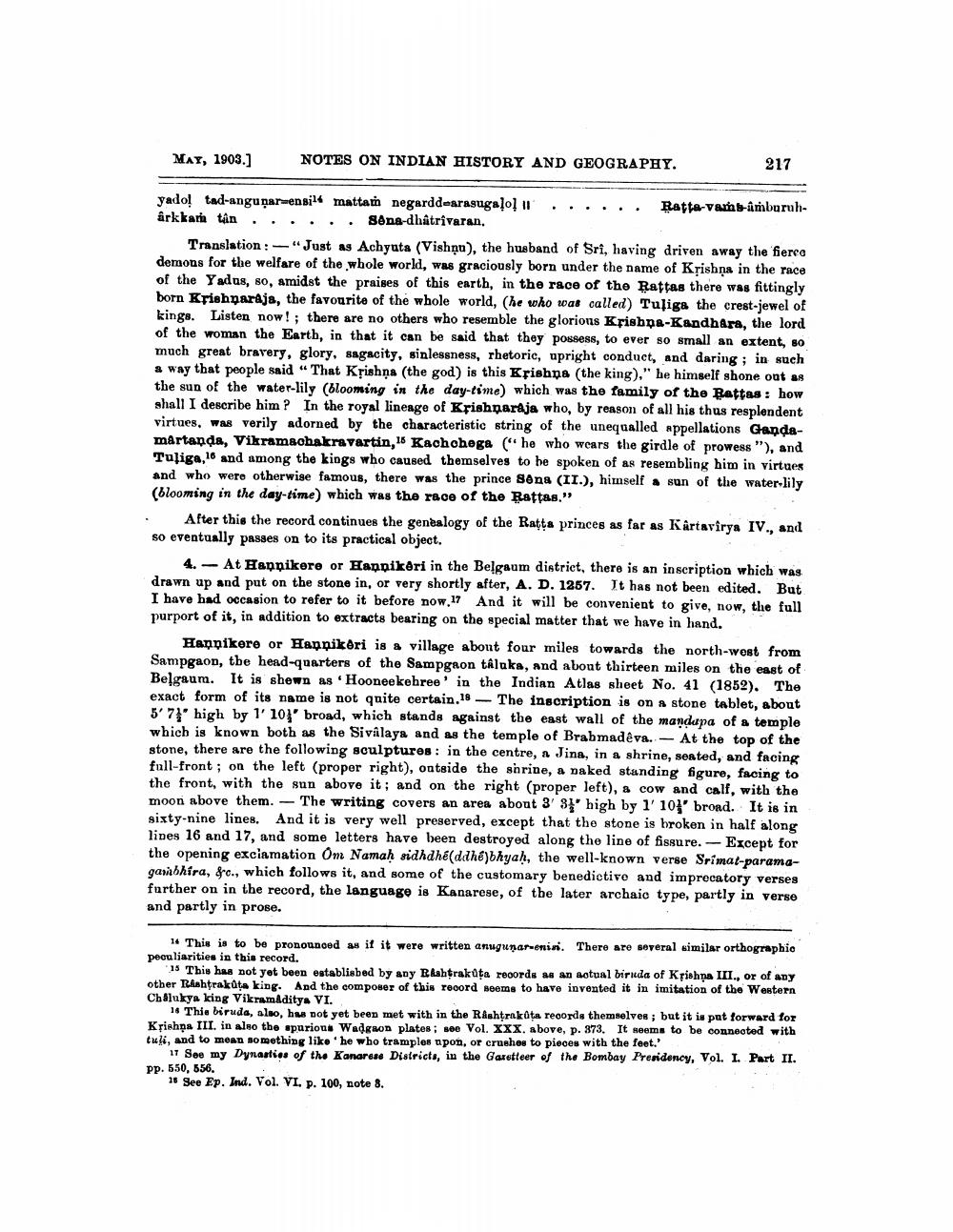________________
MAT, 1903.)
NOTES ON INDIAN HISTORY AND GEOGRAPHY.
217
yado! tad-angunarmensil mattam negarddearasugaļol II ...... Ratta-vam-amburuharkkarin tán.....Sena-dhâtrivaran,
Translation : -"Just as Achyuta (Vishņu), the husband of Sri, having driven away the fierce demons for the welfare of the whole world, was graciously born under the name of Kțishna in the race of the Yadas, so, amidst the praises of this earth, in the race of the Rattas there was fittingly born Krishnaraja, the favourite of the whole world, (he who was called) Tuliga the crest-jewel of kings. Listen now!; there are no others who resemble the glorious Krishna-Kandhara, the lord of the woman the Earth, in that it can be said that they possess, to ever so small an extent, so much great bravery, glory, sagacity, sinlessness, rhetoric, upright conduct, and daring; in such a way that people said " That Kșishņa (the god) is this Krishna (the king)," he himself shone out as the sun of the water-lily (blooming in the day-time) which was the family of the Battas : how shall I describe him? In the royal lineage of Krishnaraja who, by reason of all his thus resplendent virtues, was verily adorned by the characteristic string of the unequalled appellations Grandemartanda, Vikramachakravartin, 15 Kachchega ("he who wears the girdle of prowess "), and Tuliga, 16 and among the kings who caused themselves to he spoken of as resembling him in virtues and who were otherwise famous, there was the prince Sens (II.), himself a sun of the water-lily (blooming in the day-time) which was the race of the Rattas."
After this the record continues the genealogy of the Ratta princes as far as Kärtarirya IV., and so eventually passes on to its practical object.
4.- At Hannikere or Hannikëri in the Belgaum distriet, there is an inscription which was drawn up and put on the stone in, or very shortly after, A. D. 1257. It has not been edited. But I have had occasion to refer to it before now.17 And it will be convenient to give, now, the full purport of it, in addition to extracts bearing on the special matter that we have in hand.
Handikere or Happikori is a village about four miles towards the north-west from Sampgaon, the head-quarters of the Sampgaon tÂluka, and about thirteen miles on the east of Belgaum. It is shewn as 'Hooneekehree' in the Indian Atlas sheet No. 41 (1852). The exact form of its name is not quite certain.18 - The inscription is on a stone tablet, about 5'71 high by 1' 10' broad, which stands against the east wall of the mandupa of a temple which is known both as the Sivîlaya and as the temple of Brabmadêva. - At the top of the stone, there are the following sculptures: in the centre, a Jina, in a shrine, seated, and facing full-front; on the left (proper right), outside the shrine, a naked standing figure, facing to the front, with the sun above it; and on the right (proper left), & cow and calf, with the moon above them. - The writing covers an area about 3' 31' high by 1' 10' broad. It is in sixty-nine lines. And it is very well preserved, except that the stone is broken in half along lines 16 and 17, and some letters have been destroyed along the line of fissure. - Except for the opening exclamation Om Namah sidhdhé(ddhé)bhyaḥ, the well-known verse Srimat-paramagarbhíra, &c., which follows it, and some of the customary benedictive and imprecatory verses further on in the record, the language is Kanarese, of the later archaic type, partly in verse and partly in prose.
14 This is to be pronounced as if it were written anugunarenia. There are several similar orthographie peculiarities in this record
15 This has not yet been establisbed by any Rhahrakuţa records as an actual birida of Krishna III., or of any other Rashtrakata king. And the composer of this record seems to have invented it in imitation of the Western Chalukya king Vikramaditya VI.
16 This biruda, also, hm not yet been met with in the Rashtrakta records themselves; but it is put forward for Krishna III. in also the spurious Wadkan plates: see Vol. XXX. above, p. 873. It seems to be connected with tuli, and to mean something like he who tramples apon, or crushes to pieces with the feet.'
11 See my Dynastia of the Kanares Districts, in the Gazetteer of the Bombay Presidency, Vol. I. Part II. pp. 550, 556.
16 See Ep. Ind. Vol. VI. p. 100, note 8.




